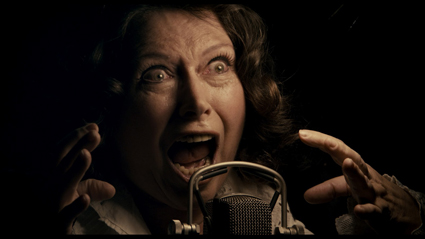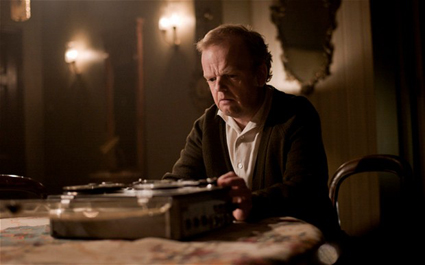 |
Berberian Sound Studio |
What is this film about? If one accepts its hypno-haunto inclination, it’s a dual text. One, a dream-narrative about Peter, a very British sound editor from the mid-70s who ends up producing sound effects for a very Italian mixer, Santini, tracking and mixing an unseen, film The Equestrian Complex, in the eponymous Italian post-production studio. The other, an audiophiliac celebration of the components, procedures and techniques for recording sound effects back then, with an ancillary appreciation of the Italian giallo subgenre of erotic thrillers produced in Italy since the 1960s.
Under hypno-haunto logic, the film fetishises the iconography and sonography of generic Library Music produced across the 60s and 70s—some of it wacky, some of it decidedly experimental. Its initial recouping came via the late 90s post-Lounge trend when European labels like Cinevox, La Douce, Plastic, Dagored and Crippled Dick uncrated rare/dismissed tracks from Italian movies, TV shows and Library Music companies. Groovy lounge music—additionally from British Library Music companies like Bosworth, Chappell and Southern—consequently formed a luridly dank sonic bed in much UK music. Berberian Sound Studio sleeps there too.
It’s a thoroughly saturated aural realm, created equally by hipsters and exploiters, sampling and processing aurally distinctive fragments and textures to signify a type of Cool Britannia re-plugging into a recent cultural past. If there are defining parameters to the hypno-haunto ethos, they are aligned to such ‘acts of listening’ wherein one identifies that something is being appropriated (though not quoted)—but so that one experiences its origins as vaguely remembered events, even though the listener is likely not to have heard the original sounds, only their redistribution through other acts of sampling and versioning. Its value as evocation supersedes its value as specification, hence the sensation of feeling the past’s incursive lay of the present via a haunting refrain.
 |
Berberian Sound Studio |
Most perplexing is how the film declares its love of the era and its artefacts (through well-researched fawning over Shears ¼-inch tape boxes, a Space Echo Tape machine etc) while curiously annulling the power with which those artefacts helped shape both experimental music and film scores. Berbian Sound Studio’s press kit has a telling line: “Santini’s (the movie’s fictional director) The Equestrian Vortex may be a schlocky giallo slasher, a classic horror, but Peter’s Berberian Sound Studio has a more absorbing, hauntological bent.” I read this after seeing the film, but found that it illustrates much of what the film illuminates for me: namely, a subtextual clash between stiff, uptight, prissy, picky, train-spotting Anglophilia and bombastic, gaudy, sensual, erotic, rapacious culture Italian-style. Yes, that’s the conflict between the film’s central characters, but the film’s shoehorning of contemporary notions of misogyny, sexploitation and B-grade categorisation ignores the fucked-up sexual terror which defines giallo and qualifies how the likes of Morricone (in Bird With The Crystal Plumage) and Goblin (in Suspiria) approached their wonderfully vicious soundtracking. Make no mistake: this film is more Harold Pinter than Lucio Fulci.
But Berberian Sound Studio should be well-liked by an Anglo ‘hypno-haunto’ audience. Retro technology abounds; it’s got a kinda Lynchian feel about it (signposted by its Mulholland Drive/Lost Highway midway dimensional inversion); it extols an ethical aversion to screen violence; the special effects evoke 60s radical cinema you can flip through on ubuweb; and further exhaustive online research for 30 minutes will lead you to single paragraph blogs with Wikipedia-links to Lucio Berio, Cathy Berberian, Dario Argento and Mario Bava. After that you’ll end up here at this review, because you used Google to search for “hypnagogic” and “hauntological.”
Berberian Sound Studio, director Peter Strickland, released June, 2012, screening ACMI, Dec 27, 2012-Jan 13, 2013; http://www.acmi.net.au/lp_berberian_sound_studio.aspx
This article first appeared in RealTime's online e-dition Jan 30, 2013
RealTime issue #112 Dec-Jan 2012 pg. 24
© Philip Brophy; for permission to reproduce apply to [email protected]








 back
back